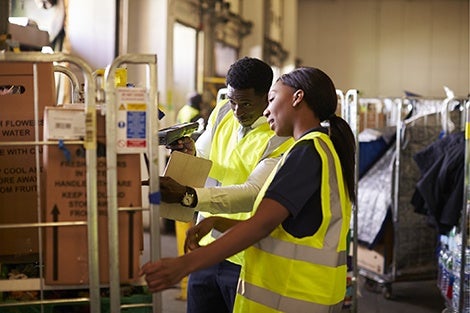For immediate release: Tuesday, February 7, 2017
Boston, MA – Women who lift heavy loads at work may experience decreased fertility, and the effect appears stronger among overweight or obese women and older women, according to a new study from Harvard T.H. Chan School of Public Health. Working non-daytime work schedules may also decrease fertility, the researchers found.
The study will be published online February 7, 2017 in Occupational and Environmental Medicine.
“Our study suggests that women who are planning pregnancy should be cognizant of the potential negative impacts that non-day shift and heavy lifting could have on their reproductive health,” said Lidia Mínguez-Alarcón, research fellow in the Department of Environmental Health and lead author of the study.
While previous studies have suggested a link between work schedule, physical factors on the job, and fecundity—the biologic capacity for reproduction—those studies didn’t directly measure biomarkers of fecundity such as levels of reproductive hormones or ovarian function, and therefore could only speculate on the possible mechanisms underlying the associations. The new study is the first to report associations between these biomarkers and occupational factors.
The researchers studied nearly 500 women seeking infertility treatment at Massachusetts General Hospital (MGH) from 2004–2015, which allowed them to directly measure many biomarkers of fecundity that can’t be measured in women attempting to conceive naturally.
The researchers looked at several biomarkers of fecundity—including the number of antral follicles (small structures in the ovary that indicate the number of immature eggs remaining in the ovary); levels of follicle-stimulating hormone (FSH); estrogen levels; and the number of mature eggs that are capable of developing into healthy embryos—and analyzed the association between these biomarkers and the physical demands and schedules of the women’s jobs, which the women reported on a questionnaire.
Moving or lifting heavy objects at work was inversely associated with both the number of antral follicles and the number of eggs among the women, the study found. Women who reported moving or lifting heavy loads at work had 8.8% fewer total eggs and 14.1% fewer mature eggs compared with women who reported never lifting or moving heavy objects at work. The inverse association between heavy lifting and mature egg yield was stronger among women who were overweight or obese and those age 37 or older.
Non-daytime schedules—including working at night or working rotating shifts—were also inversely related to egg yields.
The researchers didn’t find any association between occupational factors and either estrogen or FSH levels.
The mechanism by which moving or lifting heavy loads could affect egg quality is still unknown, the researchers said. As for how working non-day shifts may affect egg yields, the researchers speculated that it may have to do with circadian rhythm disruption.
“Our study is the first to show that occupational heavy lifting and non-day shifts may be adversely affecting egg production and quality, rather than accelerating ovarian aging. Future work, however, is needed to determine whether egg production and quality can be improved, and if so, how quickly, if these work exposures are avoided,” said Audrey Gaskins, research associate in the Department of Nutrition.
Other Harvard Chan authors of the study included Paige Williams, Jennifer Ford, Russ Hauser, and Jorge Chavarro. Irene Souter of the MGH Fertility Center was also a co-author.
Funding for the study came from NIH grants R01ES022955, R01ES009718 and R01ES000002 from the National Institute of Environmental Health Sciences (NIEHS) and L50-HD085359 from the National Institute of Child Health and Human Development (NICHD).
“Occupational factors and markers of ovarian reserve and response among women at a fertility centre,” Lidia Mínguez-Alarcón, Irene Souter, Paige L. Williams, Jennifer B. Ford, Russ Hauser, Jorge E. Chavarro, and Audrey J. Gaskins, Occupational and Environmental Medicine, online February 7, 2017, doi: 10.1136/oemed-2016-103953
For more information:
Marge Dwyer
Harvard T.H. Chan School of Public Health
mhdwyer@hsph.harvard.edu
617.432.8416
photo: iStockphoto.com
Visit the Harvard Chan School website for the latest news, press releases, and multimedia offerings.
###
Harvard T.H. Chan School of Public Health brings together dedicated experts from many disciplines to educate new generations of global health leaders and produce powerful ideas that improve the lives and health of people everywhere. As a community of leading scientists, educators, and students, we work together to take innovative ideas from the laboratory to people’s lives—not only making scientific breakthroughs, but also working to change individual behaviors, public policies, and health care practices. Each year, more than 400 faculty members at Harvard Chan School teach 1,000-plus full-time students from around the world and train thousands more through online and executive education courses. Founded in 1913 as the Harvard-MIT School of Health Officers, the School is recognized as America’s oldest professional training program in public health.
